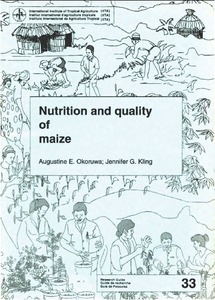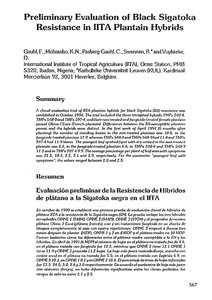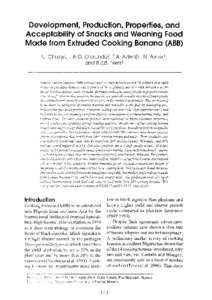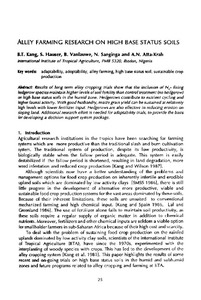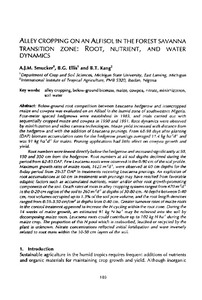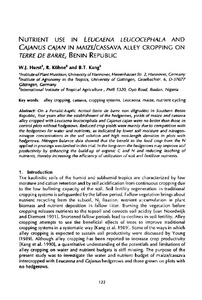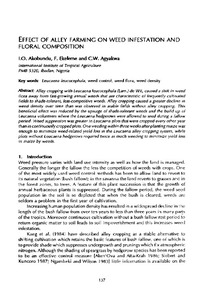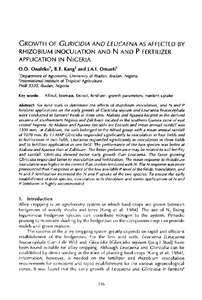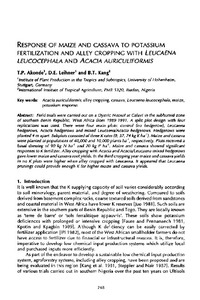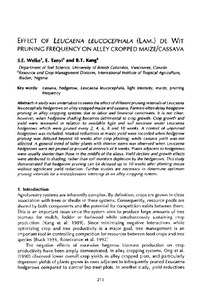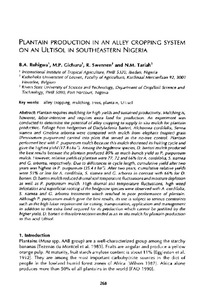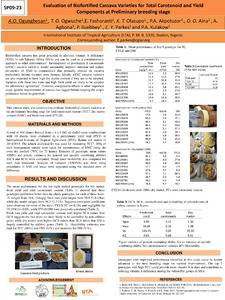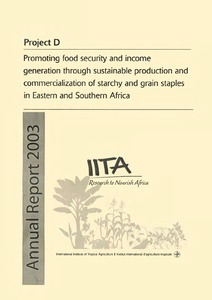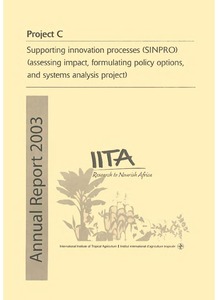Welcome to the International Institute of Tropical Agriculture Research Repository
Conference Documents: Recent submissions
Now showing items 421-440 of 597
-
Preliminary results of screening IITA improved germplasm for resistance to Cassava Brown Streak Disease (CBSD) in Uganda
(2012-02)For quite some time, cassava breeding activities of the International Institute of Tropical Agriculture (IITA) in Uganda were mainly focused on developing genotypes resistant to cassava mosaic disease (CMD), which was the major biotic production constraint since the early 1990s. Although cassava brown streak disease (CBSD) was reported some time back in 1940s, it had been dormant in Uganda. However, in early 2004, cases of CBSD were reported and re-confirmed both onstation (Namulonge) and in ... -
Preliminary evaluation of black sigatoka resistance in IITA plantain hybrids
(1994)A clonal evaluation trial of llTA plantain hybrids for black Sigatoka (85, resistance was established in October 1990. The trial included the three tetraploid hybrids TMPx 5484. TMP" 548-9and TMP" 5974. and their non-treated and fungicide-treated female plantain parent Obino l'Ewa' (French plantain}. Differences between the BS-susceptible plantain parent and the hybrids were distinct. In the first week 01 April 1991 {6 months after printing' the number of standing leaves in the non-treated plantain ... -
IPMomics: from genomics to extension for integrated pest management of cowpea: Proceedings of the 5th World Cowpea Research Conference, held at Palm Beach Hotel, Saly, Senegal. 27 September 1 October
(2012)Insect pests often develop resistance to insecticides, and such resistance represents a serious management problem. Devising methods that concurrently delay resistance and minimize injury by insects to field crops and stored grain has long been a goal of Integrated Pest Management (IPM). A centerpiece of IPM has been the combined use of biological control agents and prudent application of chemical insecticides. Unfortunately, successful application of IPM has remained a challenge. This chapter ... -
Alley farming research on high base status soils
(1995)Result of long time alley cropping trials show that the inclusion of N2- fixing hedgerow species maintain higher levels of soil fertility than control treatment (no hedgerow) on high base status soils in the humid zone. Hedgerows contribute to nutrient cycling and higher faunal activity. With good husbandry, maize grain yield can be sustained al relatively high levels with lower fertilizer input. Hedgerows are also effective in reducing erosion on sloping land. Additional research effort is needed ... -
Improving the productivities of cowpeacereal systems in the savannas of West Africa through dissemination of improved varieties and cropping systems
(2012)Cowpea (Vigna unguiculata [L.] Walp.) is the most important grain legume in the dry savannas of West Africa, however grain and fodder yields are low (averaging 25 to 300 kg and 450 to 800 kg grain and fodder/ha, respectively) due to biotic and abiotic constraints. Improved varieties and cropping systems are continuously being developed to tackle the various constraints and some of the results have shown promises in limited on-farm trials in the past. Recently IITA, in collaboration with several ... -
Alley cropping on an Alfisol in the forest savanna transition zone: root, nutrient, and water dynamics
(1995)Below-ground root competition between Leucaena hedgerow and intercropped maize and cowpea was evaluated on an Alfisol in the humid zone of southwestern Nigeria. Four-meter spaced hedgerows were established in 1983, and trials carried out with sequentially cropped maize and cowpea in 1990 and 1991. Root dynamics were observed by minirhizotron and video camera technologies. Maize yield increased with distance from the hedgerow and with the addition of Leucaena prunings. From 68-98 days after planting ... -
Nutrient use in Leucaena leucocephala and cajanus cajan in maize/cassava alley cropping on Terre de barre, Benin Republic
(1995)On a Ferralic-haplic Acrisol (terre de barre non degradee) in Southern Benin Republic, four years after the establishment of the hedgerows, yields of maize and cassava alley cropped with Leucaena leucocephala and Cajanus cajan were no better than those in control plots without hedgerows. Reduced crop yields were mainly due to competition with the hedgerows for water and nutrients as Indicated by lower soil moisture and nitrogen-nitrogen concentration the soil solution and high root-Iength densities ... -
Analysis and interpretation of alley farming network data from tropical Africa
(1995)To date, the site-specific, mixed reports of the influence of hedgerows on crap yields provide little predictive insight into which type of tree/crop combination is most appropriate for a specific location. The Alley Farming Network for Tropical Africa was established in 1989. The objectives of that network include the identification of the best hedgerow species and management practices for tropical Africa. The results of the first 3 years of network activities were assembled into a statistical ... -
Effect of alley farming on weed infestation and floral composition
(1995)Alley cropping with Leucaena leucocephala (Lam.) de Wit, caused a shift in weed flora away from fast-growing annual weeds that are characteristic of frequently cultivated fields to shade-tolerant, less-competitive weeds. Alley cropping caused a greater decline in weed density over lime than was observed in arable fields without alley cropping. This beneficial effect was reduced by the upsurge of shade-tolerant weeds and the build up of Leucaena volunteers where the Leucaena hedgerows were allowed ... -
Growth of Gliricidia and Leucaena as affected by Rhizobium inoculation and N and P fertilizar application in Nigeria
(1995)Six field trials to determine the effects of rhizobium inoculation, and N and P fertilizer applications on the early growth of Gliricidia sepium and Leucaena leucocephala were conducted in farmers' fields at three sites: Alabata and Ajaawa located in the derived savanna of southwestern Nigeria and Zakibiam located in the southern Guinea zone of ease central Nigeria. At Alabara and Ajaawa the soils are Entisols and mean annual rainfall was 1300 mm; at Zakibiam, the soils belonged to the Alfisol ... -
Response of maize and cassava to potassium fertilization and alley cropping with Leucaena leucocephala and Acacia auriculiformis
(1995)Field trials were carried out on a Dystric Nitosol at Calavi in the subhumid zone of southern Benin Republic, West Africa from 1989-1997. A split plot design with four replications was used. There were (our main plots: control (no hedgerow), Leucaena hedgerows, Acacia hedgerows and mixed Leucaena/Acacia hedgerows. Hedgerows were planted 4 m apart. Subplots consisted of three K rates (0, 37, 74 kg K ha-1). Maize and cassava were planted at populations of 40,000 and 10,000 plants ha-1, respectively. ... -
Effect of Leucaena leucocephala (Lam.) de wit pruning frequency on alley cropped maize/cassava
(1995)A study was undertaken to assess the effect of different pruning intervals of Leucaena leucocephala hedgerows on alley cropped maize and cassava. Farmers often delay hedgerow pruning in alley cropping systems due to labor, and financial constraints. It is not clear, however, when hedgerow shading becomes detrimental to crop growth. Crop growth and yield were measured in relation to available light and soil moisture under Leucaena hedgerows which were pruned every 2, 4, 6, 8 and 10 weeks. A control ... -
Plantain production in an alley cropping system on an Ultisol in southeastern Nigeria
(1995)Plantain requires mulching for high yields and sustained productivity. Mulching is, however, labor-intensive and requires extra land for production. An experiment was conducted to determine the potential of alley cropping to supply in situ mulch for plantain production. Foliage from hedgerows of Dactyladenia barteri, Alchornea cordifolia, Senna siamea and Gmelina arborea were compared with mulch from elephant (napier) grass (Pennisetum purpureum) carried into plots that served as the no-tree ... -
Pioneer woody species in Leucaena leucocephala and senna siamea hedgerows in a forest ecoysystem in southern Nigeria
(1995)Floral richness is an important feature of the tropical forest ecosystem. Large numbers of potentially useful volunteer species are usually present in crop fields in traditional farming systems. However; traditional farm lands are undergoing rapid deterioration as a result of increasing population pressure, with the resulting practice of continuous cultivation with little or no fallow. Consequently, many valuable woody species are at the verge of extinction. Work reported in the present study ... -
Alley cropping on an ultisol in southeastern Nigeria
(1995)An alley cropping trial was carried out on an acidic Typic paleudull in the humid forest zone of southeastern Nigeria using Three indigenous (Anthonotha macrophylla, Dactyladenia barteri, Harungana madagascariensis and two exotic (Calliandra calothyrsus and Flemingia macrophylla) hedgerow species. Early growth of Anthonotha was slow. Harungana and calliandra could not withstand repeated pruning and died 3 to 4 years after establishment. Dactyladenia performed better than Anthonata and Flemingia. ... -
Evaluation of biofortified cassava varieties for total carotenoid and yield components at preliminary breeding stage
(Global Cassava Partnership for the 21st Century - GCP21, 2018) -
On farm performance and farmers evaluation of cassava brown streak tolerant variety Kiroba in the Eastern zone of Tanzania
(2004)Cassava Brown Streak Disease (CBSD) is a very serious disease in many cassava growing areas of the Eastern zone of Tanzania. It is mainly confined to the lower elevations, mainly along the coast yield losses of up to 74% occur as a result of CBSD infection in some part of the Eastern zone. In the year 2001, a variety believed to be tolerant to CBSD was introduced in two villages Zogowale and Viziwaziwa in the Eastern zone in which CBSD is a big problem. The objective was to find out whether Kiroba ... -
Mycoherbicide for water hyacinth
(2003)A presentation of the theoretical approach and results of IMPECCA: International Mycoherbicide programme for Eichhornia crassipes ((Mart.) Solms) control in Africa, with particular emphasis on activities in West Africa.

